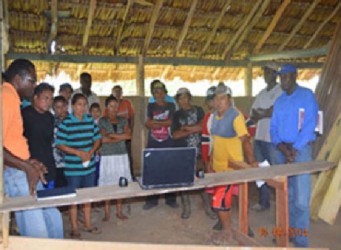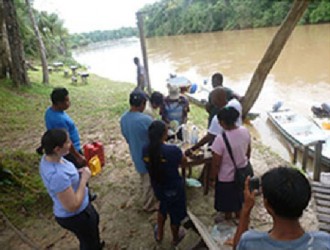A year after the Guyana Chapter of the Partners of the Americas shade house cultivation and marketing project commenced its outreach programme across large areas of Guyana delivering education and material resources primarily though not exclusively to rural communities, the organisation’s efforts are already yielding visible and significant results.
The shade house project’s proper titled is ‘the Sustainable Livelihoods and Community Economic Growth through Hydroponic and Organic Vegetable Production and Marketing Project, but for obvious reasons, the title will not be repeated in this article. It is about working with communities to create shade house farming initiatives from the ground up, and afterwards, asking the beneficiary individuals and communities to challenge themselves to turn these into sustainable ventures.

Absent from the project, which is supported by Japanese funding funneled through the Inter-American Development Bank (IDB) is the fanfare usually associated with conventional state-run projects. What is in evidence, however, is the high level of interest among poor rural communities. It is estimated that as many as 1,000 persons and several communities have already been ‘touched’ by the shade house project and the Partners functionaries are now beginning to spread themselves even more thinly.
Project Director Kelvin Craig said that with the project just a year old Partners is already buoyed with the response. What the project has done is to offer a viable option to its target audiences that includes training in shade house farming and technical and material support in the building of shade houses. The other facet of the project is the marketing of the produce. That will take time to fructify.
Up until now the most noteworthy accomplishment of the project may well be the role that it has played in rekindling a measure of interest in farming in coastal communities including urban ones, where residents, it seemed, had long lost the appetite for the traditional kitchen garden. That, in an encouraging number of instances, appears to be changing.
Setting aside the emergence of several modestly successful shade house farming initiatives which have emerged under the tutelage of Partners volunteers, the work which the project has done with individuals and communities appears to have led to a resurgence of ‘container cultivation’; the once common practice of planting in discarded pots, bottles and bowls. The example of the project delivered by differently able children at the David Rose School – and which is reported in this issue – offers a compelling example of just how much yield a discarded container can deliver.
Rural farmers who have already erected shade houses to add to their existing conventional acreage have also benefited from consultation with the Partners Project, while, for the newcomers, modest investments of time and resources in creating shade houses with Partners’ direct support and assistance has added a sense of both social and entrepreneurial purpose to their lives. The prospect that their shade house pursuits could grow into useful business ventures provides an additional incentive for what they do.

Arguably, the marketing aspect of the project could present the biggest challenge. Shade house adherents have responded well to the tutoring and support with the building of structures and the cultivation of crops. Marketing is a different challenge. Its success depends on the ability of the project to recruit more stakeholders, sections of the business community like municipal markets, supermarkets and other commercial outlets.
There may well be some examples of successful marketing initiatives in the shade house sector, but marketing on the whole remains a mountain to climb. One issue to note here is that successful marketing will depend heavily on reliability of supplies.
Partners, however, can take heart from the fact that there is, already, a considerable measure of awareness of the availability of shade house produce among some urban supermarkets, while shade house-produced vegetables are now customarily offered for sale in some coastal markets.
Nor is Partners unmindful of the impact that its shade house project has had on recruiting new converts to the agricultural sector. Its seminars and practical sessions at St Stanislaus Farm at Sophia routinely attract attendees ranging from experienced farmers seeking to try the shade house methods to curious amateurs. Craig believes that one of the genuine successes of the project reposes in the fact that it may well have recruited to the sector, newcomers who are prepared to begin with a few small containers and perhaps at some later stage, invest in a much more elaborate shade houses.
In coastal communities, schools, churches, youth groups and other organisations are on the Partners list for training and for support with the building of shade houses. It is, for the most part, the uninitiated who appear to be taking to what the project has to offer and while the project makes no such claim, it appears that we may be witnessing a ‘limited revolution’ to redirect attention to the virtues of food cultivation.
Founded in 1964 Partners of the Americas links US states with Caribbean and Latin American countries in partnerships that marry the enthusiasm and skills of local citizen volunteers and their institutions and communities with expert volunteers from the United States. Collectively, they seek to tackle shared concerns of a social, economic or cultural nature. The local Partners Chapter is linked with Mississippi and works on projects in diverse areas including health and agriculture.
It is in agriculture and primarily in shade house farming that Partners has made its impact here.
Craig says that such success as the project has realised up to this time is due in considerable measure to its collaborative work with the National Agricultural Research and Extension Institute (NAREI), Inter-American Institute for Cooperation in Agriculture (IICA), Food and Agriculture Organisation (FAO), Conservation International (CI) – Guyana, Iwokrama and the Society for Sustainable Operational Strategies (SSOS). Amongst them these organisations possess both the scientific understanding of agriculture as well as the experience of having undertaken various other projects in far-flung communities across the country.
Hinterland communities have had sustained interaction with these organisations and have reported worthwhile benefits. In January and June this year the FAO and IICA held accountability seminars with participants in community shade house projects while CI – Guyana held its National Stakeholder Workshop on the study of the state of food and agriculture in the Rupununi in March.
Craig said NAREI can be credited with the creation of the first known set of shade houses in Region Nine 9 at the St Ignatius Secondary School. At Aranaputa, the SSOS also commenced a shade house initiative about two years ago.
In October last year the FAO, in collaboration with IICA, established another shade house at the Bina Hill Institute at Annai. These projects have served to enhance hinterland receptivity to shade house farming while creating a basis for the extant collaboration amongst Partners and the various other groups including the Caribbean Self Reliance International (CASRI). The collective initiative has seen the creation of five shade houses at Karanambo, Rupertee and Aranaputa. These are already in production.
During the recent field visit to the region, the team held discussions with interested groups and individuals at Lethem, Katoonarib, Shulinab, Rewa, Apoteri, Annai and Surama. Already there is an agreement to support the effort of the Katoonarib Farmers Group which is benefiting from a GEF/UNDP Small Grants Programme.
Challenges still lie ahead. Some repose in the effort it will take to sustain interest in the shade house production beyond the life of the project itself. In interior communities, there are also challenges associated in sustaining the shade house culture in circumstances where various forms of food security pursuits compete for attention. There are, however, advantages in the grounding, which many communities have already received in shade house production.
In its most recent report, Partners painted an upbeat picture of the response among Region Nine farmers. On the whole, Partners said, there is much room for optimism.





